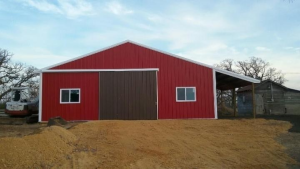Readers –
The following is from the Dear Pole Barn Guru questions I get weekly, and the issues are so important when it comes to dealing with a contractor, I wanted to take time out to hi-light a few of them.
 DEAR POLE BARN GURU: I have some serious issues with a pole barn I recently had built! I hired a general contractor to build it for me knowing it would be a little more expensive but that way if there was any issues it was his responsibility to deal with subcontractors. Well it’s been a nightmare ever since the sub he hired to construct it didn’t set the man door at the right height so when the concrete crew poured the floor they went off the bottom of the man door instead of the garage doors which is the proper way to do it. Well when they went to do the apron they discovered the siding was three inches below where the concrete had to be so they had to cut the wainscot three inches. I decided to start taking measurements! This is a 30×40 building and none of the posts are on center. They are anywhere from 16 inches off to 2 inches off center on an 8 foot span. The roof joists are supposed to be 4 foot span but they are all over the place too! Anyway he’s trying to tell this is ok it’s still structurally sound and I shouldn’t worry about it! Anyway you get the picture. He wants his money and I am refusing to give final payment till I get another contractor to look at it and give me a cost estimate to fix the problems his sub screwed up on. What’s your thoughts on the way I’m handling it? CONFOUNDED IN CABLE
DEAR POLE BARN GURU: I have some serious issues with a pole barn I recently had built! I hired a general contractor to build it for me knowing it would be a little more expensive but that way if there was any issues it was his responsibility to deal with subcontractors. Well it’s been a nightmare ever since the sub he hired to construct it didn’t set the man door at the right height so when the concrete crew poured the floor they went off the bottom of the man door instead of the garage doors which is the proper way to do it. Well when they went to do the apron they discovered the siding was three inches below where the concrete had to be so they had to cut the wainscot three inches. I decided to start taking measurements! This is a 30×40 building and none of the posts are on center. They are anywhere from 16 inches off to 2 inches off center on an 8 foot span. The roof joists are supposed to be 4 foot span but they are all over the place too! Anyway he’s trying to tell this is ok it’s still structurally sound and I shouldn’t worry about it! Anyway you get the picture. He wants his money and I am refusing to give final payment till I get another contractor to look at it and give me a cost estimate to fix the problems his sub screwed up on. What’s your thoughts on the way I’m handling it? CONFOUNDED IN CABLE
DEAR CONFOUNDED: Most people who hire contractors to construct their new pole buildings are living in a delusional world where unicorns bound happily through fields of flowers and the sun always shines. They have the idea the contractor is going to handle everything to their satisfaction, it will be a pain free situation and their new building will be perfect.
I now give you permission to return to reality.
Statistically, only about 50% of all new building owners are pleased with the performance of their contractor… ½ … not very good odds.
On to the question posed – what my thoughts are on the way the situation is being handled.
I am not an attorney, so my answers are not to be construed as legal advice, consider them as being words of wisdom based upon decades of judicious experience. Hopefully issues can be resolved before money has to be poured into the sinkhole which is our legal system.
If you have not done so before, carefully read through the written agreement signed between you and your contractor. In most cases, this agreement and ONLY this agreement is going to be the basis for any legal standing you would have in court. Make sure to read all of the fine print, as well as the terms and conditions on the back.
Poorly written or vague contracts protect only the contractor – not you. Pretty much anything not specifically spelled out in writing, isn’t going to happen.
If you are not feeling bad yet – it is probably only going to get worse.
You may have some recourse on structural issues. Call the inspector who has been doing the inspections on the building, and have he or she meet with you to compare the engineer sealed plans for the building, against the building as it has been built. The inspector’s duty is to “red tag” the building and provide a list of structural defects which need to be corrected by the contractor prior to the building being occupied.
In the event your building did not require a building permit, or you are in a jurisdiction which does not provide structural inspections, you may very well be at the mercy of what the builder claims is “good”. If this is the case, you could try contacting the engineer who designed the building, providing he or she with a list of structural deficiencies – the engineer may put some pressure on the builder to correct them, or may provide a sealed letter which says the building is structurally sound as constructed.
Outside of the above two paragraphs, if the building conforms to what is outlined on the agreement and the roof doesn’t leak – your best bet is to swallow the bitter pill and pay up. Consider it a sad lesson learned the hard way.
 Well, one of our steel vendors (who does a fabulous job at getting the right pieces, in the right quantity to hundreds of our clients annually) had one of those “no idea” moments recently and we ended up with a couple of good-natured clients who just could not get the track covers they were sent to fit….because they were bent to the wrong profiles!
Well, one of our steel vendors (who does a fabulous job at getting the right pieces, in the right quantity to hundreds of our clients annually) had one of those “no idea” moments recently and we ended up with a couple of good-natured clients who just could not get the track covers they were sent to fit….because they were bent to the wrong profiles!





